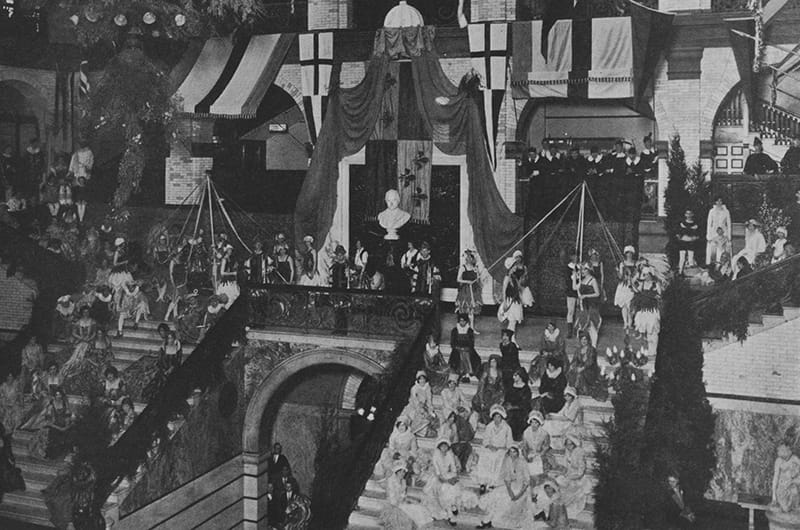Ask the Archivist: Gathering 'Round the Maypole for the Spring Festival

After you've worked or taught at Drexel for a while, you've observed some unusual things inside the Great Court of the Main Building. But have you ever seen a group of people dancing around a maypole in the Great Court? You probably haven’t, for it's been nearly 90 years since the demise of the Drexel Institute's annual Spring Festival.
Spring traditionally begins around March 20 with the vernal equinox, when night and day are approximately even. In Philadelphia we often see snow on the ground in March, and too often April feels less like spring than the tail of winter. It was on the first weekend of May when Drexel held its annual Spring Festival, beginning in 1926.
The Spring Festival had three primary parts: musical and dramatic performances, academic displays and athletic carnivals. The Festival was usually preceded by a senior ball on Thursday night, as seniors celebrated their approaching graduation with music and dancing in the Great Court. The following day the Spring Festival would begin with student performances and expositions by the academic departments.
The Spring Festival had three primary parts: musical and dramatic performances, academic displays and athletic carnivals. The Festival was usually preceded by a senior ball on Thursday night, as seniors celebrated their approaching graduation with music and dancing in the Great Court. The following day the Spring Festival would begin with student performances and expositions by the academic departments.
The departmental expositions provided the opportunity for professors to show off their disciplinary innovations to a wide audience. In 1930, for example, a demonstration by the business administration faculty offered a look at "the use of charts and statistics in business." Home economics faculty discussed purchasing policies for the homemaker, civil engineering students showed their scale model of a steel arch bridge, while chemists used their new labs in Curtis Hall to demonstrate the Tyndall effect. Electrical engineering faculty demonstrated the exciting new technology of the day, television, "including the reception of broadcasts from New York."
Down the road at the Drexel Athletic Field, the ROTC band launched the athletic carnival with a concert performance. Then the games began: track and field events ranging from the broad jump and the shot put to the 100- and 440-yard dashes. The carnival concluded with an afternoon baseball game.
Musical and dramatic performances spanned the weekend. Student groups performed popular songs of the era (such as "Pale Moon") and operas like Verdi's “Il Trovatore.” The Glee Club offered Gilbert and Sullivan's “Trial by Jury.” Each year the May Fete was the highlight of the weekend: Fencers fenced, clowns clowned, English folk songs were sung, and myths from the Greek and Norse traditions were enacted. Finally, the cast would dance around the maypole and the May Queen was crowned.
The Great Depression and World War II interrupted the Spring Festival, and what was to be a brief pause became a decade-long delay. Upon its return in 1946, the festival was smaller in scale, simply a day of musical performances. It's possible that no one danced around a maypole in the Great Court ever again.
Drexel News is produced by
University Marketing and Communications.

